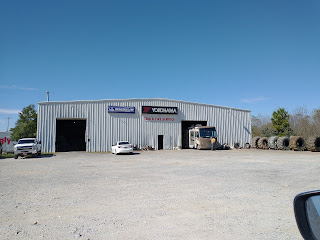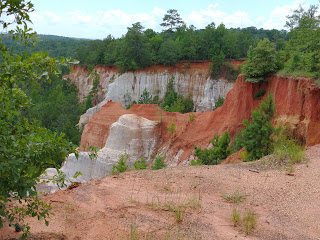Our original plans for the day were to take a couple of hikes a little further south down at Little River Canyon. But those plans were disturbed early in the day, after Ray went out to add air to one of the tires that looked low. We have a TPMS (tire pressure monitoring system) that reports on pressure and temperature of each of the 6 tires on the RV. I was inside when I heard Ray yelling that the tire was losing air. In using the tire inflator, the valve stem of that tire popped out, and air was hissing out of the tire. Ray was able to finally cap it, but not before the tire had lost a lot of pressure. Our only option now, was to find a tire shop and get the stem repaired. We were leaving for home the next day, and couldn't ride long-term on that tire without the danger of a blowout. Fortunately, it was early in the day, and we were only 20 minutes from a nearby town that did have a place that could help. So, we packed everything up, pulled in the slides, and drove down to Fort Payne (very carefully) to get the tire stem fixed. The people at the tire shop were very accommodating and helpful, and took us right away. About 20 minutes later, we were on our way back to the campground to re-set up, and get on with our day.
By now, it was afternoon, and we headed south to Little River Canyon. We took a hike along the river to a beautiful spot with a smaller falls (than Little River Falls a bit further north). During the summer, this area is a popular swimming place (called the Hippie Hole). Fortunately for us, since it was the middle of the week in fall, we mostly had the area to ourselves. It's a rocky area that defines a large pool just beyond the falls. The trail down is rocky and root-y, and the last little bit is a rock staircase of 160 (someone else counted them) steep steps. Nice trail, beautiful spot.
We then decided to drive the road along the canyon. It doesn't have lots of views, but the road itself is a hoot. Continuous ups and downs, around hairpin curves. There are warning signs at the road's entry points that the road is impassable to trucks, trailers and RVs. With the Elantra, it was just a matter of continuously managing the stick shift.
Tomorrow begins the drive home.
Photos here:







































